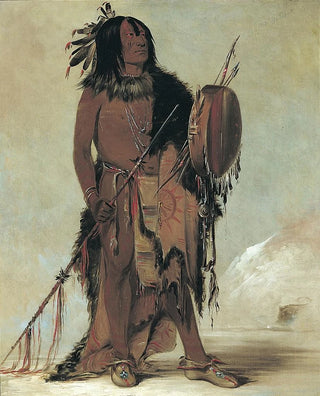Art print | Wnnestou White Buffalo, an old healer - George Catlin


View from behind

Frame (optional)
In the fascinating world of American art, the artwork "Wnnestou White Buffalo, an Elder Healer" by George Catlin stands out for its profound humanity and commitment to Native American culture. This iconic piece, created in the 19th century, is much more than a simple pictorial representation. It evokes a world in transformation, a time when the traditions and lifestyles of indigenous peoples were at risk. Catlin, as a keen and passionate observer, offers us a window into a often little-known reality, inviting us to contemplate the wisdom and spirituality of the healers within these communities.
Style and uniqueness of the artwork
Catlin's style is characterized by a realistic approach and meticulous attention to detail, reflected in the depiction of Wnnestou White Buffalo. The vibrant colors and rich textures of his painting capture the very essence of his subject, paying tribute to the dignity and wisdom of this elder healer. The artist employs painting techniques that highlight the contrast between light and shadow, creating an atmosphere that is both serene and powerful. Every element of the composition, from traditional clothing to facial expressions, is carefully designed to convey a story, an emotion. This painting transcends a simple portrait to become a living testament to the culture and beliefs of the Sioux, offering the viewer an immersion into a rich and complex spiritual world.
The artist and his influence
George Catlin, often regarded as the father of Native American portraiture, dedicated his life to documenting the indigenous cultures of North America. Traveling across the continent, he encountered numerous tribes, striving to capture their way of life, rituals, and traditions through painting. His work had a significant impact on the perception of indigenous peoples, helping to raise awareness of their history and culture. Catlin was also a passionate advocate for their cause, campaigning for the preservation of their lands and lifestyles in the face of colonial expansion. Through his paintings, he managed to immortalize fleeting moments, thus creating a

Matte finish

View from behind

Frame (optional)
In the fascinating world of American art, the artwork "Wnnestou White Buffalo, an Elder Healer" by George Catlin stands out for its profound humanity and commitment to Native American culture. This iconic piece, created in the 19th century, is much more than a simple pictorial representation. It evokes a world in transformation, a time when the traditions and lifestyles of indigenous peoples were at risk. Catlin, as a keen and passionate observer, offers us a window into a often little-known reality, inviting us to contemplate the wisdom and spirituality of the healers within these communities.
Style and uniqueness of the artwork
Catlin's style is characterized by a realistic approach and meticulous attention to detail, reflected in the depiction of Wnnestou White Buffalo. The vibrant colors and rich textures of his painting capture the very essence of his subject, paying tribute to the dignity and wisdom of this elder healer. The artist employs painting techniques that highlight the contrast between light and shadow, creating an atmosphere that is both serene and powerful. Every element of the composition, from traditional clothing to facial expressions, is carefully designed to convey a story, an emotion. This painting transcends a simple portrait to become a living testament to the culture and beliefs of the Sioux, offering the viewer an immersion into a rich and complex spiritual world.
The artist and his influence
George Catlin, often regarded as the father of Native American portraiture, dedicated his life to documenting the indigenous cultures of North America. Traveling across the continent, he encountered numerous tribes, striving to capture their way of life, rituals, and traditions through painting. His work had a significant impact on the perception of indigenous peoples, helping to raise awareness of their history and culture. Catlin was also a passionate advocate for their cause, campaigning for the preservation of their lands and lifestyles in the face of colonial expansion. Through his paintings, he managed to immortalize fleeting moments, thus creating a






